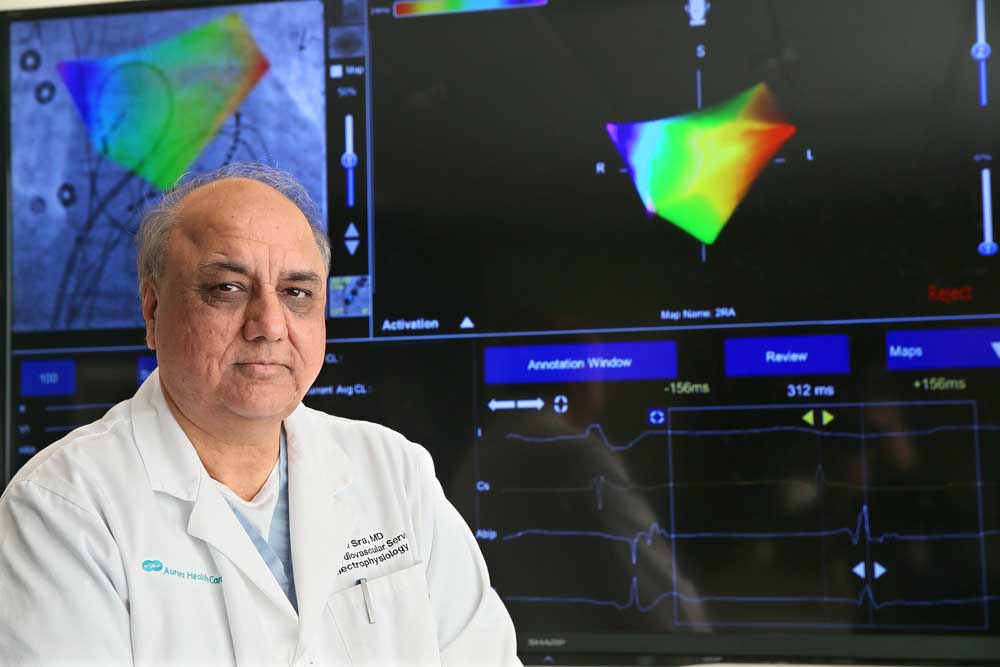Doctor forms company for cheaper arrhythmia treatment
Published 12:00 am Thursday, April 21, 2016

- Michael Sears / Milwaukee Journal SentinelCardiac electrophysiologist Jasbir Sra of Aurora Health Care developed a less costly system to provide 3-D images when doing ablations to treat heart arrhythmia.
MILWAUKEE — The technology commonly used in the United States to treat certain types of irregular heartbeats is remarkably effective — and remarkably expensive.
An X-ray machine that displays the heart in three dimensions can cost $500,000. The disposable catheter that allows a cardiologist to locate and destroy heart tissue that’s causing the irregular beats costs more than $3,000.
Jasbir Sra, a cardiac electrophysiologist with Milwaukee’s Aurora Health Care, set out in 2010 to find a less-expensive approach, hoping to make the procedure more widely available, particularly in the developing world.
Millions of dollars and a million lines of computer code later, Sra and his company have created a computer program that should allow the procedure to be done with far less-costly equipment.
“Obviously you spend sleepless nights thinking about it,” said Sra, who invested almost all of his personal wealth plus some borrowed money in the project. But he added, “I honestly never had a doubt it could be done if we were persistent.”
On Feb. 26, the company, APN Health LLC, received clearance from the Food and Drug Administration to market the new system, named Navik 3D.
The system can create 3-D maps of a heart chamber using basic patient monitoring and fluoroscopic imaging systems found in hospital catheter labs.
That could enable physicians to accurately pinpoint the place in a heart that is causing arrhythmias — irregular or unusually fast or slow heartbeats — without the need for the additional, costly 3-D-mapping equipment.
APN Health spent much of last year working to improve the technology and make it easier to use. That work will continue.
“There are some upgrades we want to do to make the system even more seamless,” Sra said.
The tentative plan is to use the system for six months at one Aurora medical center and then test it at other medical centers. In a year, Sra would like to have it in 10 to 15 medical centers.
“We have a lot of work ahead of us,” said Barry Belanger, a retired engineer from GE Healthcare, who was among the first people Sra approached with the idea. “But what’s important is what we were able to put behind us.”
Ablation
Some arrhythmias, particularly a type known as SVT, for supraventricular tachycardia, can be treated by “ablation,” in which a catheter is inserted through a vein in the groin and threaded to the heart to scar or destroy the tissue that is triggering the abnormal rhythm.
Ablation in some cases also is used to treat atrial fibrillation, the most common arrhythmia and a condition that affects 2.7 million to 6.1 million people in the U.S., including almost one in 10 people over 65, according to the Centers for Disease Control and Prevention.
How APN Health developed its technology is an example of changes in the economy that can give a startup company access to highly specialized skills once found only in large corporations.
Sra gradually put together a virtual company of mathematicians, physicists and engineers from throughout the country as well as India to work out the highly complex math and engineering challenges.
They ranged from someone with an expertise in high-speed convolution algorithms — basically the removing of blurring from images — to someone with expertise in winning regulatory approval for a new technology.
Sra started with a group of five people — three in Milwaukee, one in San Francisco and one in Seattle — to work on the initial problems. The group eventually expanded to about 30.
About a dozen people, some who are stockholders, work more or less full-time for the company as contract employees. Others worked on specific projects.
The company has spent about $15 million, including several million dollars in legal fees, developing the technology, said David Geddam, a biomedical engineer who is APN Health’s director of product development.
Aurora Health Care and some friends of Sra also invested in the company.
The result is technology that has the potential to lower health care costs. That’s not the norm in health care: Most new technology increases health care spending.
Sra, who has taught in India and other countries, estimates that 90 percent of ablation procedures worldwide are done without 3-D mapping.
The standard patient monitoring and fluoroscopic imaging systems found in cath labs give physicians a two-dimensional image of the heart and the catheter’s location.
The third dimension — depth — enables physicians to identify with greater precision the area in the heart triggering the irregular heartbeats and the location of the catheter, thereby limiting or preventing damage to healthy sections of the heart.






